
 Q&A: Gregorio Millett, vice president and director of Public Policy at amfAR
Q&A: Gregorio Millett, vice president and director of Public Policy at amfAR
Millett, Senior Policy Ad-visor in the Office of Na-tional AIDS Policy.
By Richy Rosario
According to the Centers for Disease Control and Prevention (CDC), in 2010, Black gay men ages 13-24 accounted for 4,800 new HIV infections—more than twice as many as their White and Latino counterparts. Can community-based organizations administered and led by Black gay men, such as Us Helping Us in Washington, D.C.—which was cited this fall during the White House Briefing on Obamacare and the LGBT Community for its high rates of Affordable Care Act (ACA) enrollment—help reverse the trend?
We spoke to Gregorio Millett, currently vice president and director of public policy at amfAR and a former CDC researcher, to find out.
How can community-based organizations administered by Black gay men or people of color help reduce HIV rates among young Black gay men?
Data consistently shows that more Black gay men tend to be diagnosed with HIV in community-based organizations that cater to the Black community rather than at health departments or private providers. This is important because once people know that they are HIV positive, they take steps to keep from infecting partners who are HIV negative. Another issue is cultural competency and stigma. Although many health departments and private providers are capable of diagnosing and regularly diagnose Black MSM, there are sometimes issues with cultural competency among staff or even stigma faced by Black MSM that become major barriers toward getting tested.
Stigma also affects prevention resources devoted to Black MSM—the clear majority of infections in the Black community—as compared with other Black populations at lower risk for HIV infection. We have data from some health departments that shows that, although Black gay men are more likely to test positive for HIV than other members of the Black community, Black MSM are less likely to be targeted for HIV testing or HIV-prevention programming. The Wisconsin Department of Health recently found that Black MSM made up 58 percent of Blacks who tested positive but only 19 percent of targeted HIV tests among all Blacks , and 11 percent of targeted HIV-prevention services among all Blacks. If a group represents nearly 60 percent of HIV diagnoses in a population, then why aren’t its members receiving 60 percent of tests and 60 percent of HIV-prevention activities? It would not happen in community-based organizations run by, devoted to and targeting Black MSM.
Many young Black gay men say they feel more accepted and comfortable at places like Us Helping Us and GMAD. What difference does feeling accepted make in terms of adherence and seeking treatment?
Being accepted makes a difference in both HIV prevention and care. While I was with the CDC, my colleagues and I published a research paper examining social support among Black and Latino MSM and its relationship to men knowing their HIV status. We found that Black MSM who had more social support in their lives were more likely to test for HIV and less likely to have HIV and not know it.
Sometimes the acceptance that is important is personal acceptance. A colleague, Gary Harper at the University of Michigan, recently published a study of HIV-positive young MSM of color and found that having an affirming ethnic identity and sexuality acceptance were both associated with a lower tendency to miss clinical-care visits for HIV. This is important because HIV-positive young gay men of color are more likely than young HIV-positive white gay men to miss their clinical appointments, and missing clinical appointments is associated with worse personal health outcomes, as well as a greater likelihood of being infectious to others.
Can you say more about how being accepted changes the way Black gay men receive HIV-prevention messages?
Sara Nelson Glick, a professor at George Washington University, looked at data from a national survey administered to a representative sample of Americans asking whether homosexuality was “always wrong.” She found that approximately 72 percent of the Black community in the 1970s responded that homosexuality was always wrong, and that number had not changed much by 2008. Moreover, in 2008, gay men in the survey who believed that homosexuality was always wrong were more likely to be Black. Worse, men who believed that homosexuality was always wrong were less likely to get tested for HIV.
Thankfully, things are changing rapidly. We have a Black president and attorney general who have done more for LGBT civil rights and HIV among gay men than has been done at any time in U.S. history. We also have LGBT children of high-profile Black celebrities such as Magic Johnson and Isiah Thomas, who publicly and adamantly support their children, and many Black celebrities as well as the NAACP supporting gay marriage. Hopefully this changing acceptance will help reduce HIV infections.
Why are some HIV-prevention techniques not reaching young Black gay men, and what needs to be done?
Actually, compared with young white gay men, young Black gay men are less likely to engage in unprotected sex and use drugs associated with HIV infection, and have fewer sex partners. The issue is not that young Black gay men are putting themselves at more risk. The issue is that HIV infection has continued to increase in this community for decades without substantive intervention from the federal government, or concern from the larger Black or gay communities. There are so many HIV-positive Black gay men that even though these men engage in less-risky behaviors, they are more likely to encounter someone who is HIV positive than gay men in communities with less HIV.
We need more than messaging for young Black gay men. We need to make sure that young Black gay men have access to health insurance and are enrolled in a health insurance plan under the ACA so that they have access to HIV-prevention services as well as care. We must also make sure that young Black MSM have access to the most effective prevention technologies, such as pre-exposure prophylaxis.
Richy Rosario wrote this story as part of a community-health-reporting fellowship from the International Center for Journalists in Washington, D.C.





Be the first to comment